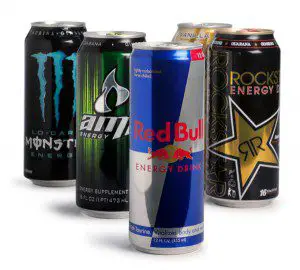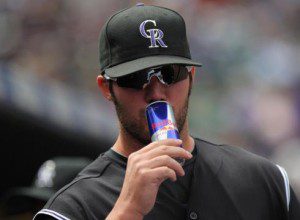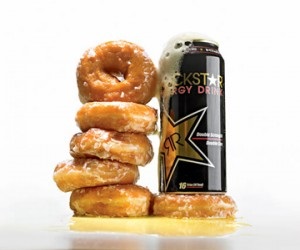By Katrin Geist, MSc
Guest Writer for Wake Up World
They have been on the shelves for years, touted to boost energy levels, increase alertness and wakefulness, and to provide cognitive enhancement. In short: to improve performance. Quite fitting for a performance driven, time-scarce society that seems to run on legal drugs such as caffeine, alcohol, and prescription drugs, suggesting a state of constant and ever increasing productivity as the gateway to lasting happiness.
Some people think there’s something amiss when they don’t feel stressed. Stress has become the new normal, the predominant being state for many. In go the cups of coffee to sustain us a wee while longer. In go the so-called energy drinks, too, their use and effects extending to ever younger customers (Ibrahim & Iftikhar 2014). But how do those drinks actually affect our physiology? How do they influence individuals, and perhaps even society at large? Do they truly give us a beneficial boost? Or is it all just bull….? Let’s find out.
[pro_ad_display_adzone id=”110028″]
The rise of energy drinks
The popularity of energy drinks has grown exponentially, with a 240% increase in sales between 2004 and 2009. Over 200 brands exist in the U.S. alone, purporting to increase performance, energy, longevity, and vitality in some way (Heckman et al. 2010) – claims that remain largely unsubstantiated (Johnson et al. 2014, Burrows et al. 2013, but see Abian et al. 2015) and questionable (Grasser et al. 2015). Red Bull holds the biggest market share and sold over four billion units in 160 countries in 2011 (Burrows et al. 2013), 1.5 billion of them in the US (Ibrahim & Iftikhar 2014). An incredible success story, given this Austrian company only started in 1987. Since the 1960s, when energy drinks from a Japanese pharmaceutical company first arrived on the scene, this market segment has now grown into a multibillion dollar industry, reportedly the fastest growing segment in the beverage industry since bottled water (Heckman et al. 2010). Sales of energy drinks reached an estimated 12.5 billion USD in 2012.
Who drinks it?
After multivitamins, energy drinks are the most popular dietary supplement used by American adolescents and young adults (Johnson et al. 2014). Adding children to the mix, these three population groups use the most energy drinks, consuming about 50% of drinks sold in over 140 countries (Ibrahim & Iftikhar 2014).
US military personnel also turned out avid consumers, with products readily available on bases worldwide: about 44% reported using at least one drink daily, and almost 14% indicated having three or more drinks per day (Johnson et al. 2014).
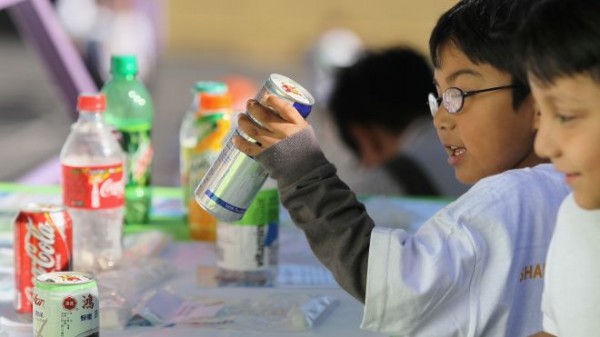
What’s in it?
Anatomy of an energy drink: caffeine, taurine (an amino acid), glucuronolactone, sugar (although sugar-free and even organic varieties exist now), ginseng, guarana (the highest caffeine containing plant in the world), yerba mate and green tea extracts, gingko biloba, kola nut, trace minerals, antioxidants, B vitamins, in varying proportions, to yield what manufacturers call an “energy blend” (Higgins et al. 2010). Main active ingredients are usually caffeine and taurine. Brands vary considerably in their caffeine content (Johnson et al. 2014), many of them offering 70-80 mg per serving (that’s about three times the concentration in cola drinks) (Seifert et al. 2011), and some of them far exceeding these amounts: the highest reported concentration was 505 mg per container (Ishak et al. 2012). Energy drinks also contain surprisingly high levels of sodium. Onestudy reported a median sodium level of 123 mg per 8 oz. serving or shot, more than three times the amount in soda. Several energy drinks had even higher levels, one containing 340 mg per 8 oz. serving (Pomeranz et al. 2013).
How energy drinks affect us
While some studies found positive effects on cognitive performance (visual information processing, attention) and mood (Ishak et al. 2012), and also physiological parameters (Abian et al. 2015), others found no effects, or concluded there was no therapeutic benefit from consuming energy drinks (Seifert et al. 2011). Ingredients may be present in insufficient amounts to cause any effects (Higgins et al. 2010). Those studies finding positive effects attributed them largely to caffeine (Ishak et al. 2012), one of the main energy drink ingredients, and the world’s most widely consumed stimulant (e.g. 54% of US adults drink an average of three cups of coffee a day) (Persad 2011).
It is unclear whether or not any performance increasing or adverse effects relate to substances other than sugar and caffeine (Johnson et al. 2014), the latter being the best examined ingredient by far (Higgins et al. 2010). While components such as ginseng, yerba mate, or vitamins enjoy a good reputation in supporting health, and others like glucuronolactone are little investigated, two reviews pointed out that only few studies looked at the combined, synergistic effects of all ingredients (as offered by an energy drink), and that those studies showed mixed results, not allowing to draw any definite conclusions one way or another (Seifert et al. 2011, Burrows et al. 2013). The effect of energy drinks may well be dose dependent, where small, controlled amounts evoke a recognized benefit (e.g. enhanced mental alertness or physical performance, see Abian et al. 2015) and larger amounts may lead to undesired ill-effects (Rath 2012). Energy drink consumption may also lead to excessive daytime sleepiness and reduced reaction time, negating any positive short-term effects (Ishak et al. 2012).
Several case studies offer evidence of adverse cardiovascular effects of excessive energy drink consumption, even though causality remains difficult to establish (Breda et al. 2014, Goldfarb et al. 2014). However, the same authors stressed that these cases are likely severely underreported by doctors, and suggest the FDA (US Food and Drug Administration) create a nation wide registry for energy drink related health issues to determine the true significance and number of events. Afterall, the FDA has not yet moved ahead with legislating energy drinks due to lack of sufficient data (Goldfarb et al. 2014). Meantime, other authors point out the danger of arrhythmia or cardiac arrest (Goldfarb et al. 2014, Higgins et al. 2010), and death (Seifert et al. 2011) due to energy drink overconsumption. Combination with alcohol, a habit common among college students (Heckman et al. 2010), and also observed in U.S. military personnel (Johnson et al. 2014), exacerbates negative effects (Breda et al. 2014). Other adverse health effects of excessive energy drink consumption include possible acute hepatitis, acute renal failure, increased risk of seizures, severe anxiety, psychosis, headache, irritability, agitation, lightheadedness, tremors, and confusion (Johnson et al. 2014, Wolk et al. 2012, Rath 2012).
While Abian et al. (2015) found aspects of elite badminton players’ games improve through controlled energy drink consumption, Johnson et al. (2014) reported no positive effect on athletic performance, and a recent study looking at adolescent energy drink consumption and its risk suggests to not consume any such drink before and after sports (Sanchis-Gomar et al. 2015), a viewpoint shared by Rath (2012), who says drinking these beverages before and during exercise may lead to dehydration as well as tremors, heat stroke, or heart attacks. To be fair on above badminton study, one must clearly emphasize the difference between controlled, adequate intake and excessive consumption of energy drinks, as is likely among youth who are 1) potentially unaware of caffeine levels of such drinks, 2) prone to peer influence (Striley & Khan 2014), and 3) likely unaware of the consequences of rapidly drinking more than one energy drink – a vastly different scenario from a controlled ingestion that takes body mass into account.
Effects of Caffeine
According to Striley & Khan (2014), 90% of adults, 83% of 13-17 year olds, and 63% of 6-12 year olds consume caffeine daily, as also echoed by the caffeine dependence in adolescents reported by Wolk et al. (2012).
Seifert et al. (2011) sum it up very well: “Caffeine, the most commonly used psychoactive drug worldwide, may be the only psychoactive drug legally available over-the-counter to children and sold among food and beverage products. In healthy adults, a caffeine intake of 400 mg/day is considered safe. Acute clinical toxicity begins at 1 g, and 5 to 10 g can be lethal. Adolescent and child caffeine consumption should not exceed 100 mg/day and 2.5 mg/kg per day, respectively. For example, 8 oz of Red Bull provides 77 mg of caffeine, or 1.1 mg/kg for a 70-kg male or 2.2 mg/kg for a 35-kg preteen. Whether the effects of caffeine in adults can be generalized to children remains unclear. Caffeine may affect future food and beverage preferences by acting on the developing child’s brain reward and addiction center; this effect may be gender specific. A study of 12- to 17-year-olds revealed that boys found caffeinated soda more reinforcing than did girls regardless of usual caffeine consumption.”
And Ishak et al. (2012) add that caffeine doses greater than 300 mg/ day can induce or exacerbate anxiety – people with psychiatric disorders should carefully consider caffeine levels before consuming any energy drinks. This pertains also to those with underlying heart disease (Higgins et al. 2010).
Effects of Taurine
Taurine, the other common main ingredient of energy drinks, may interact negatively with caffeine and alcohol, as reported by a case study of a patient presenting with acute renal failure after combining an energy drink (4.6g taurine, 780mg caffeine) with vodka (Ishak et al. 2012). Energy drinks containing a combination of taurine and caffeine were also linked to the deaths of European athletes, prompting some countries to limit or ban sales (Rath 2012).
Social and Behavioral Effects and the Role of Marketing
Consumption of energy drinks among adolescents is associated with other potentially negative health and behavioral outcomes such as sensation seeking, increased risk-taking behavior, use of tobacco and other harmful substances, and binge drinking. It is also associated with a greater risk for depression and injuries that require medical treatment (Breda et al. 2014, Striley & Khan 2014, Heckman et al. 2010).
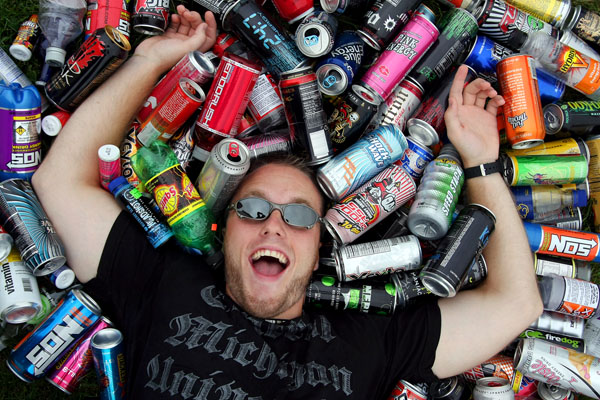
Energy drink marketing strategies include sporting event and athlete sponsorships, alcohol-alternative promotion, and product placement in media (including Facebook and video games) oriented to children, adolescents, and young adults (Seifert et al. 2011). In 2010, US adolescents saw on average 124 television ads for energy drinks and shots, equating one ad every three days (Pomeranz et al. 2013). Marketing towards young men openly promotes psychoactive, performance enhancing, and stimulatory effects (Higgins et al. 2010). Some brands even attempt to glorify drug use, one of them advertising itself as “the legal alternative” to cocaine. Such aggressive marketing of energy drinks and the association of some brands with athletes and sporting events has led to many athletes consuming energy drinks before competitions to improve performance or to recover expended energy after competition (Breda et al. 2014). Given the influence the media have on our society, and especially on young people, this, combined with above mentioned cautions by researchers to avoid energy drinks before and during sports, is worrying.
In a New Zealand survey, all age groups (spanning ages 16 to 35) stressed the importance of peer influence on consumption and commented on the sex-specific marketing strategies of energy drink producers. Authors studying a US population found an association between a “traditional masculine ideology” and energy drink consumption. Together, these studies illustrate the influence of identity and marketing on energy drink consumption across ages and locations (Striley & Khan 2014).
Effect on Society at Large
Energy drinks often contain sugar (e.g. high-fructose corn syrup, sucrose, glucose) and/ or artificial sweeteners in high amounts: one can (or 500 ml) typically provides 54 g. That’s about 13 teaspoons – slightly more than ¼ cup! Long-term excessive consumption of simple sugars may cause obesity and lead to insulin resistance, potentially resulting in diabetes (Higgins et al. 2010). Other excess sugar effects include dental erosion, premature aging, low serotonin levels, and upsetting the healthy balance of bacteria in the GI tract (Rath 2012).
In the US in 2008, sugary beverages constituted 31% of added sugar in the diet of 6–11 year olds and 44% in diets of 12–17 year olds. Although total added sugar intake derived from sugary beverages has decreased since 1999, added sugar intake from energy drinks has increased. Consistent with sales data, youth may be substituting energy drinks for other sugary beverages (Pomeranz et al. 2013). Given that the largely unregulated (see below) market and degree of consumption of energy drinks increase every year (Ishak et al. 2012), with many people regularly consuming energy drinks, there is an increased risk of obesity (Breda et al. 2014), with childhood obesity already representing a great health concern around the world.
And it’s not only the sugar. Known negative consequences of increased caffeine consumption among children and adolescents include effects on the neurological and cardiovascular systems, which can cause physical dependence and addiction (Breda et al. 2014, Wolk et al. 2012), increased rates of hypertension, insomnia, chronic headaches, motor tics, irritability, learning difficulties, and others. Many of these adverse effects are dose dependent (Rath 2012). The American Academy of Pediatrics stated that “energy drinks have no place in the diet of children and adolescents” due to their “stimulant content”, but energy drink manufacturers continue to advertise directly to adolescents in media also viewed by children (Pomeranz et al. 2013). The US Substance Abuse and Mental Health Services Administration reported a ten-fold increase in emergency room visits involving energy drinks between 2005 (1,128 visits) and 2009 (13,114 visits), tendency increasing. These pertained to use of energy drinks alone with no other drug or substances added in the majority of cases (56%). Most of the adverse effects and toxicities associated with energy drinks have been attributed to their high caffeine content (Goldfarb et al. 2014). Since mixing caffeine with alcohol exacerbates negative effects, together with limited and varied regulations, energy drinks could pose a public health risk. Breda et al. (2014) recognize energy drink consumption and toxicity as an extensive and growing problem in Australia and the United States.
As mentioned, energy drinks can contain high levels of sodium, and diets rich in sodium may result in high blood pressure and increased risk for heart disease and stroke (Pomeranz et al. 2013).
Health care systems the world over already struggle, with ever increasing running costs. Consequences of vast energy drink consumption by significant segments of a populace may indeed affect those systems in time, given that intoxication, diabetes, or cardiovascular disease, for example, are possible outcomes that necessitate medical attention. Future studies will show how relevant the “energy drink factor” really is.
Regulation of Energy Drinks
Countries differ widely in their regulation of energy drinks: while some ban them outright (Uruguay) or restrict their distribution to pharmacies and by consumer age (Sweden), others enforce stricter labeling rules in varying degrees (EU, Canada, AUS, NZ), while still others classify them as dietary supplements, allowing for lax rules around content and label declarations (USA) (Breda et al. 2014, Higgins et al. 2010, Heckman et al. 2010).
In the US, there is no upper limit for caffeine in energy drinks, as FDA rules which limit caffeine concentrations in foods do not apply to energy drinks – they classify as dietary supplements (Seifert et al. 2011). Consequently, energy drinks often contain more caffeine than is declared on the label, as the caffeine content originating from other additives (such as guarana or kola nut) must not be disclosed. Norway, Denmark, and France previously banned the sale of Red Bull, partly in response to a study on rats that were fed taurine and exhibited bizarre behavior, including anxiety and self-mutilation (Higgins et al. 2010). These countries have since relaxed their rules, because the European Court of Justice found a ban to be an improper trade restriction (Pomeranz et al. 2013) (I cannot refrain from thinking “sounds like TPPA….”). Energy drinks can currently be sold in any EU member state (Breda et al. 2014). Turkey banned all highly caffeinated varieties (Seifert et al. 2011).
In Conclusion
I mingled with Red Bull exactly once, for one sip. A taste of liquid gummi bear just does not satisfy my palate. However, I can see the appeal for kids. At the moment, it is largely up to parents to educate their children about energy drink use. Limited ingestion by healthy people is not likely to cause major adverse effects, but binge consumption or consumption with alcohol may lead to adverse events. And why children would ever be exposed to caffeine at all, I do not know. Not a drink I would offer them.
Manufacturers claim that energy drinks are nutritional supplements, which shields them from the caffeine limits imposed on sodas and the safety testing and labeling required of pharmaceuticals (Seifert et al. 2011). Yet, beyond case reports, there are little published data clearly establishing the safety profile of energy drinks in healthy people (Johnson et al. 2014), while the negative effects of excess caffeine are well established. The positive effects of many other additives (e.g. taurine or glucuronolactone) remain unclear, as do combined effects of these ingredients present in energy drinks (Higgins et al. 2010). Would it not be prudent to establish harmlessness before selling a product to millions of – often under age – consumers?
For more articles like this, sign up to our monthly Healthy Living Newsletter or like us on facebook! You can also connect on YouTube. Website: HolisticHealthGlobal.co.nz
Article Sources:
- Abian P, Del Coso J, Salinero JJ, Gallo-Salazar C et al. 2015. The ingestion of a caffeinated energy drink improves jump performance and activity patterns in elite badminton players. Journal of Sports Sciences, 2015 Vol. 33, No. 10, 1042–1050.
- Breda JJ, Whiting SH, Encarnação R, Norberg S, Jones R, Reinap M, and Jo Jewell. 2014. Energy drink consumption in Europe: a review of the risks, adverse health effects, and policy options to respond. Frontiers in Public Health 2014 (2): 1-5.
- Burrows T, Pursey K, Neve M and P Stanwell. 2013. What are the health implications associated with theconsumption of energy drinks? A systematic review. Nutrition Reviews® Vol. 71(3):135–148
- Goldfarb M, Tellier C and G Thanassoulis. 2014. Review of Published Cases of Adverse Cardiovascular Events After Ingestion of Energy Drinks. Am J Cardiol 2014;113:168-172.
- Grasser EK, Dulloo AG and J-P Montani. 2015. Cardiovascular and Cerebrovascular Effects in Response to Red Bull Consumption Combined With Mental Stress. Am J Cardiol 2015;115:183-189.
- Heckman MA, Sherry K, and E Gonzalez de Mejia. 2014. Energy Drinks: An Assessment of Their Market Size, Consumer Demographics, Ingredient Profile, Functionality, and Regulations in the United States. Vol. 9, 2010—COMPREHENSIVE REVIEWS IN FOOD SCIENCE AND FOOD SAFETY 2010 (9): 303-317.
- Higgins JP, Tuttle TD and CL Higgins. 2010. Energy Beverages: Content and Safety. Mayo Clin Proc. 2010;85(11):1033-1041.
- Ibrahim NK, Iftikhar R. 2014. Energy drinks: Getting wings but at what health cost? Pak J Med Sci 2014;30(6):1415-1419. OPEN SOURCE
- Ishak WW, Ugochukwu C, Bagot K, Khalili D and C Zaky. 2012. ENERGY DRINKS: Psychological Effects and Impact on Well-being and Quality of Life — A Literature Review. Innov Clin Neurosci. 2012;9(1):25–34.
- Johnson LA, Foster D, and JC McDowell. 2014. Energy Drinks: Review of Performance Benefits, Health Concerns, and Use by Military Personnel. MILITARY MEDICINE, 179, 4:375, 2014.
- Persad LAB. 2011. Energy drinks and the neurophysiological impact of caffeine. Frontiers in Public Health 2011 (5): 1- 8.
- Pomeranz JL, Munsell CR, and JL Harris. 2013. Energy drinks: An emerging public health hazard for youth. Journal of Public Health Policy (2013) 34, 254–271.
- Rath M. 2012. Energy drinks: What is all the hype? The dangers of energy drink consumption. Journal of the American Academy of Nurse Practitioners 24 (2012) 70–76.
- Sanchis-Gomar F, Pareja-Galeano H, Cervellin G, Lippi G and CP Earnest. 2015. Energy Drink Overconsumption in Adolescents: Implications for Arrhythmias and Other Cardiovascular Events. Canadian Journal of Cardiology, in press.
- Seifert SM, Schaechter JL, Hershorin ER and SE Lipshultz. 2011. Health Effects of Energy Drinks on Children, Adolescents, and Young Adults. Pediatrics 2011;127:511–528.
- Striley CW and SR Khan. 2014. Review of the energy drink literature from 2013: findings continue to support most risk from mixing with alcohol. Curr Opin Psychiatry 2014, 27:263–268.
- Wolk BJ, Ganetsky and KM Babu. 2012. Toxicity of energy drinks. Curr Opin Pediatr 2012, 24:243–251.
Previous articles by Katrin Geist:
- Navigating the Plastic Jungle – Understanding What’s What PLUS Easy Ways to Adjust Your Plastic Use
- Striking the Balance: Why Optimal Body pH Matters and How to Achieve It
- The FAT Facts: Butter vs Margarine
- The Power of Convictions and How They Shape Our Lives
- 10 Significant Reasons Why Regularly Drinking Green Tea Is An Awesome Healthy Living Habit!
- Cradle to Cradle Design – How a Biochemist and an Architect Are Changing the World
- Truly Healing From Cancer and Preventing It Altogether
- How to Lose Your Mind and Create a New One
- Research Shows Promising Effects Treating Advanced Cancer with Light Frequencies
- Depression & Anxiety: Discover 3 Powerful, Drug-Free Ways that Help Thousands, Naturally
- The Power of Suggestion – Are You Asking the Right Questions?
About the author:
Katrin Geist, BA, MSc, combines her interests in consciousness, personal transformation, and natural healthcare as Reconnective Healing practitioner, speaker, and author. Her monthly “Healthy Living Newsletter” offers original articles like this one on relevant natural healthcare topics.
Katrin has held international Reconnective Healing clinics in several countries and currently works from her New Zealand office in Dunedin. To contact her for personal or remote sessions, send an email to [email protected], or call 0064 (0)21 026 95 806 NZ mobile).
Katrin’s website and blog at HolisticHealthGlobal.co.nz also offer more information on Reconnective Healing and how it helps people regain and retain their wellbeing – naturally and effortlessly: no pills, no needles, no side-effects. Trying this process may well be the best thing you ever did! No more than 3 sessions required to find out what difference this may make for you.
- Website: HolisticHealthGlobal.co.nz
- Facebook: Holistic Health Global Ltd
- Email: [email protected]
- Phone: 0064 (0)21 026 95 806 (NZ mobile)
[pro_ad_display_adzone id=”110027″]

